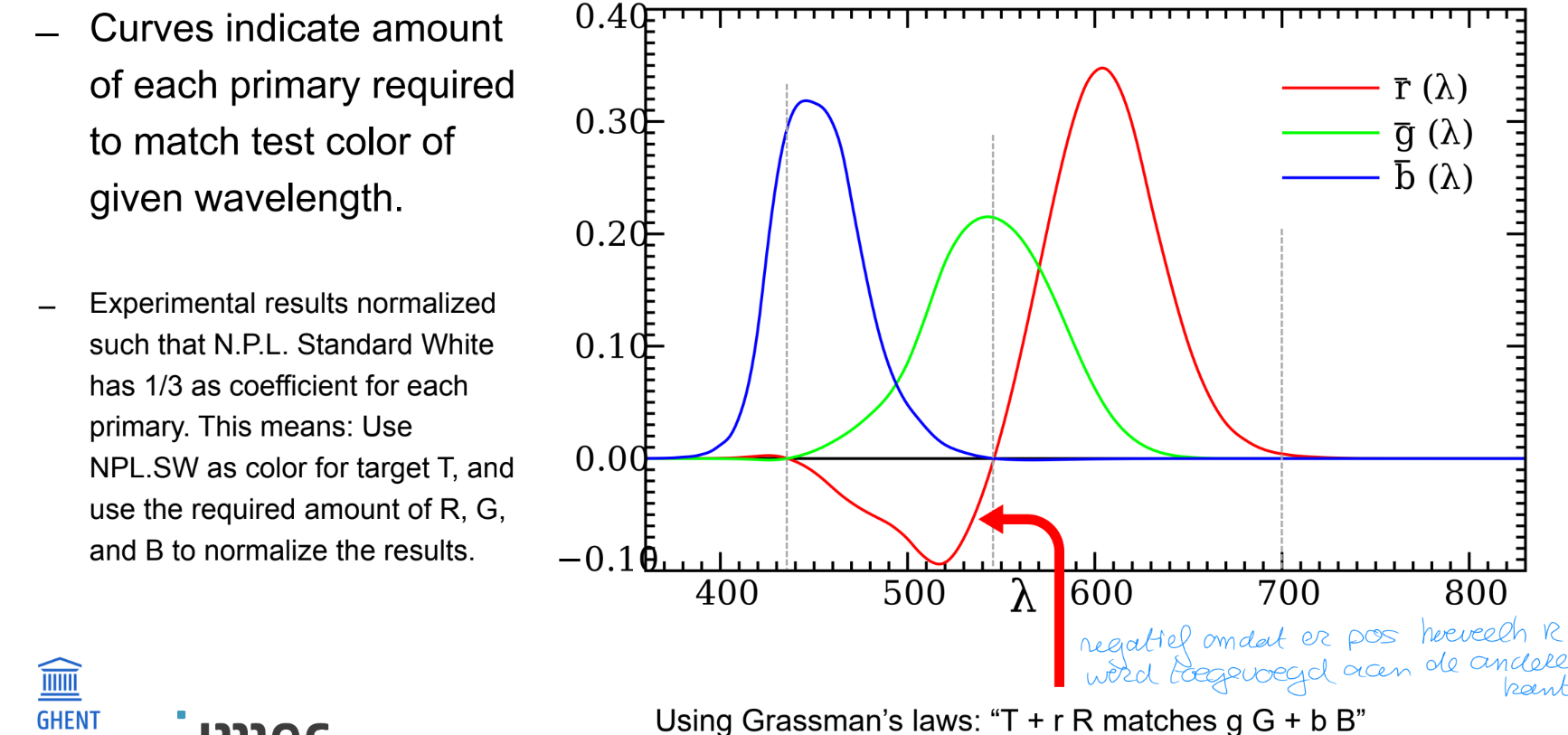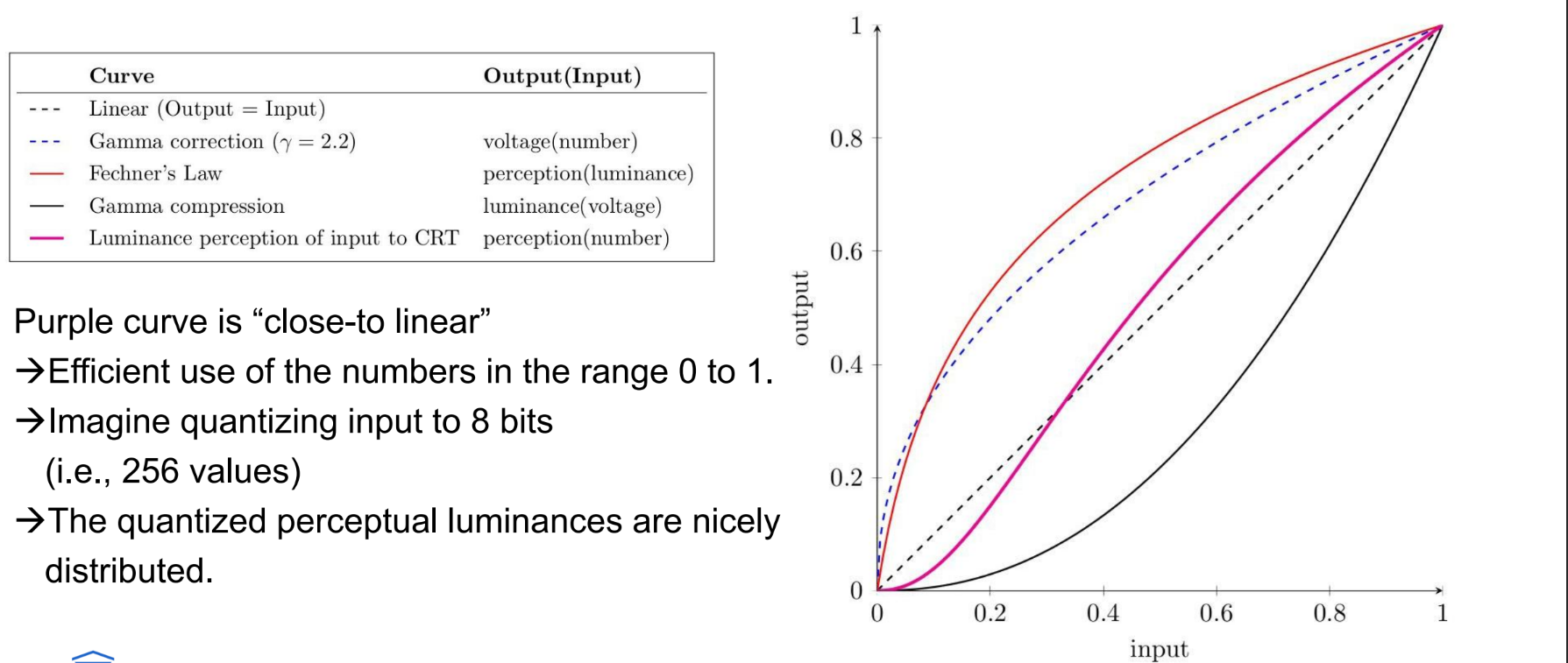MM - Chapter 3: Color in Image and Video
1/17
There's no tags or description
Looks like no tags are added yet.
Name | Mastery | Learn | Test | Matching | Spaced |
|---|
No study sessions yet.
18 Terms
Introductie tot begrippen rond licht, leg uit:
wat is “Light”?
wat is “monochromatic light”?
wat is “non monochromatic light” (+ spectrum van lichtbron)?
Light = A ‘stream’ of photons
Speed of light (c) determined by medium
Photons have wave-particle duality:
Frequency (f), and wavelength (λ): λ = c/f
Energy (E): E = 1239.9/λ, expressed in electron volts (eV)
Monochromatic light = a stream of photons with the same energy (i.e., the same wavelength, the same frequency) (vooral lasers)
Non monochromatic light = light contains photons of different wavelengths
A spectrum E λ of a light source = distribution of wavelengths
Bespreek de “perception of color”.
The perception of color:
We have light-sensitive receptors (cones)
respond to light on the retina
responses are processed by our brain and generate the perception color
Rods react also to light, but only when there is not enough light for the cones to work properly
night vision, yielding black-and-white visuals
Color is perceived in our brains
light has no intrinsic property ‘color’ to it
“without a human observer, there is no color”
Light is a physical phenomenon with properties that can be measured
Human vision is much more subjective and context-dependent
Definition of color (Wyszecki & Stiles, 2000):
“without a human observer, there is no color”
Much more complicated than it would seem at first glance
Changes with illumination
Varies between observers
Varies within an observer over time
Definitie colorimetry (kort) en Grassman’s laws (4)
colorimetry = science of color measurement and description (human observation)
Grassman’s laws: basis for color matching and colorimetry
symmetry law: if color stimulus A matches color stimulus B, the B matches A
transitive law: if A matches B and B matches C, then A matches C
proportionality law: if A matches B, then alphaA matches alphaB, where alpha is a positive scale factor
additivity law: A+C matches B+C, if and only if A matches B
Bespreek “cone responses” (gebruik Spectral power distribution in je antwoord).
Wat is metamerism?
Three types of cones: respond to Long, Medium, and Short (L,M,S) wavelengths
The sensitivity (i.e., magnitude of response) for each cone type depends on the wavelength
light is a stream of photons.
-> The composition of the light can be expressed by a Spectral Power Distribution (SPD) describing the energy J per second (= power W ) for every wavelength λ nm over a given surface [m²]
Cone Response
Mixing of light means mixing of SPDs
Cone responses to SPD is modelled by integration of the product of SPD Φ(λ) and respective cone response functions: L(λ), M(λ), S(λ)

As long as two light sources generate close enough L, M, and S values, we will perceive them as having the same color.
Their spectrum can be significantly different: metamerism.
Two SPDs generate the same L, M, and S values after integration
We say: “the colors match”Two lights that appear to have the same color, might have different SPDs
Bespreek de color matching experiments
Two experiments: David W. Wright & John Guild
Ask people: “Match monochromatic light T by mixing monochromatic lights R, G, and B”
This question is repeated for several wavelengths of the target T
The R, G, and B primaries are of fixed wavelength
(R: 700nm, G: 546.1nm, B: 435.8nm)
Using Grassman’s laws: “T matches r R + g G + b B”
Resultaten:

conclusie: the R, G, B values of a color uniquely defines its appearance
(Rigorous system of defining & communicating colors!)
Geef de standaard(en) voor LMS
CIE RGB 1931
CIE (Commission internationale de l’éclairage)
Standardized the RGB data from Wright-Guild
Defined a linear transformation to construct a color space with some desired properties: XYZ
CIE XYZ 1931 (requirements)
All three x λ , y(λ), and z(λ) ‘response’ curves should be positive for all wavelengths.
y(λ) should be the luminous efficiency function V(λ).
The equal energy illuminant E should map X = Y = Z.
All possible colors should have positive coefficients.

Bespreek “Chromaticity coordinates”.
Idea: separate luminance / brightness from the hue (i.e. `the color’ of the color; the hue and saturation).
Uniformly scaling XYZ coordinates by factor makes color only brighter or darker
Invertible
Color space: xyY

Terminology
Hue: direction of the color, relative to the white point.
Saturation: distance from the white point.
Brightness: lightness/darkness of the color.
Wat is sRGB?
“standaard RGB”
the most commonly-used RGB color space (which indeed uses an RGB color model)
Well-defined chromaticities for R, G, and B, which are not monochromatic (their SPD is not)
Well-defined white point: D65
Well-defined gamma curve
Used by HTML; and probably your monitor; and JPEGs and PNGs
Bespreek het witpunt in een RGB color space.
Wat is wit?
witpunt:
An RGB color space typically choses one specific color as “the white point”.
Practically, this means that this color is obtained by the corresponding RGB tuple (1, 1, 1).
It is the color you obtain when combing the three primaries at their maximal strength.
This is done by choosing the intensities of the primaries such that they effectively yield the white-point color when combined.
wat is wit:
depends on the context
can be used to describe the ‘color’ of a perfect diffuser (theoretisch object dat al het licht in visuele spectrum reflecteert daterop valt)
can be the white point of the color space (color obtained when setting three primaries to max power → rgb(1,1,1)
of bvb wit wnr we praten over kleur van lightbulb (subjectief), ene miss wat warmer/kouder
Bespreek Chromatic Adaptation.
Our brain filters out the influence of the ambient light.
-> We tend to see “the color” of the object itself.
-> This is modelled by dimming and amplifying the LMS responses in our eye.
Described in Color Appearance Models (CAMs)
Simplest form uses the Hunt-Pointer-Estevez transform and applies rescaling on the LMS channels (von-Kries adaptation)
The scaling is chosen such that a pixel that appears to be “white” because the object is a white reflector; maps to some preferred white point, such as D65.
Finally transform back to the color space of the display device (e.g.: your monitor, or printer).
Bespreek “Color Appearance”.
Large spectral overlaps in cone responses
-> less efficient as source for visual cortex
-> evidence that these are pre-processed
First indications by Herring (1878)
certain hues can’t co-exist in a single color sensation
encoded in the same (neuro) pathways
easy to test yourself (color after-effect)
Wat zijn additive en subtractive color modes?
additive: RGB, LMS etc (alle eerder geziene color spaces zijn additief)
subtractive:
Cyan, Yellow, Magenta, Key/Black (CMYK)
Start with white paper; and take away reflected light by adding pigment.
Halftoning puts many small dots, which blend additively in your brain.
Bespreek Gamut of color spaces en out-of-gamut colors
The gamut of a device contains all colors the device is capable of producing.
sRGB gamut
Primaries are not lasers!
What about colors that are not in the sRGB triangle? “out-of-gamut colors”
Out of gamut for RGB models if any of the components is less than 0, or greater than 1.
Negative coefficients : color too saturated = out of the triangle on the CIE xy-diagram
Coefficients > 1: Color too bright for the device.
meerdere technieken om proberen op te lossen:
clipping
rescaling
compression: bvb reinhard tone mapping
Actually, the gamut is a 3D volume. So the out-of-gamut property of a color is more complex then what was visualized on the previous slide.
Bespreek Gamma Correction.
Legacy from CRT televisions:
Non-linear relation between input voltage and emitted light (see earlier)
Roughly modelled like this: light emitted = (input voltage)^2.2,
(input voltage and emitted light are normalized to dimensionless 1)Need to compensate (‘correct’) the voltages for this non-linear behaviour: ‘gamma correction’
Adopted by many RGB color space definitions today
Modern monitors simulate this effect like a CRT

opmerking: dit zijn engineering tricks om (perceived) quality te verbeteren of transmissie errors te verminderen, deze technieken zijn niet physically supported or accurate.
Bespreek color space transformations
engineers invented transformations that aim to optimize quality per bit (YCbCr), andere transformations have been designed to be user friendly in terms of understanding and making colors (HSL/HSV)
Basic Approach
Compute normalized tristimulus values of the primaries + matrix
Compute scaling factors for correct white point mapping
Since the white point should map to equal-energy white (1,1,1 in RGB), we solve for the scaling factors S=[Sr,Sg,Sb] such that
Combine into a single matrix
Bespreek YUV en de 2 soorten televisie die hiermee te maken hebben. (later nog in H4)
YUV
YUV codes a luminance signal equal to Y′: the “luma”
Y′ = 0.299R′ + 0.587G′ + 0.144B′
Chrominance refers to the difference between a color and a reference white at the same luminance: U and V
U = B′ − Y′ and V = R′ − Y′

For gray (R′ = G′ = B′):
the luminance Y′ equals to that gray (since 0.299+0.587+0.114 = 1.0)
the chrominance (U, V) is zero
televisies:
Black and white television:
CRT gamma causes the need to apply gamma correction: Y′ = Y^(1/2.2)
Where Y is indeed the technically-correct luminance; like in CIE XYZAll TV stations broadcast gamma-corrected signals
Modulated on a carrier signal (with a carrier frequency)
See later in chapter 4
Y’ is indeed gamma-corrected luminance here in this case
Color television introduction
Wish to be backwards-compatible with existing black-and-white televisions
Thus, the luminance channel should be kept; and the missing information to obtain full color should be added
Colors specified in some “YUV”-flavoured color space
Y is the luminance channel; much like before
U and V are chrominance channels; modulated on other subbands (slightly different carrier frequencies)
Bespreek Y’CbCr adhv de 2 soorten tv die hiermee te maken hebben.
Color TV (ITU Rec-BT.601)
Y’ channel should be kept, but was gamma corrected!
The new channels were defined as:
U = B′ − Y′
V = R′ − Y′But notice how they are defined by subtracting Y’, and gamma-corrected B/R channels. But Y’ is not the gamma-corrected luminance, but instead actually is (defined as):
Y′ = 0.299R′ + 0.587G′ + 0.144B′
Thus, in Rec-BT601, Y’ is a mix of gamma-corrected R’, G’, and B’ values, using the arbitrary weights above. This is what is called “luma”
HDTV (ITU Rec-BT.709)
Redefined Y’ once again!
Y′ = 0.2126R′ + 0.7152G′ + 0.0722B′Again, more confusion is created: these coefficients are the coefficients one would need to calculate luminance, if you were doing it right: with physically-linear R, G, and B; instead of gamma-corrected R’, G’, and B’
Bespreek Y’IQ
I and Q are a rotated version of U and V
Y′ in YIQ is the same as in Y’UV; U and V are rotated by 33°:
I = 0.492111(R′ − Y′) cos 33° − 0.877283(B′ − Y′) sin 33°
Q = 0.492111(R′ −Y′) sin 33° + 0.877283(B′ −Y′) cos 33°